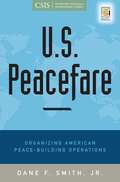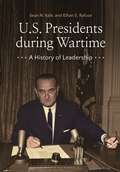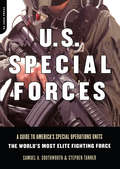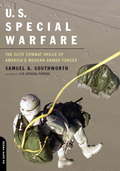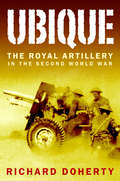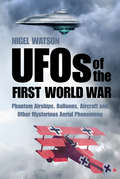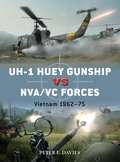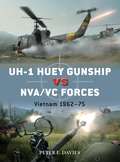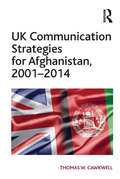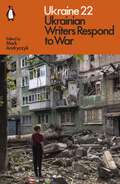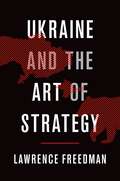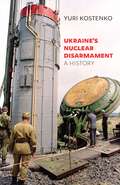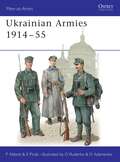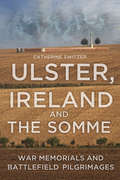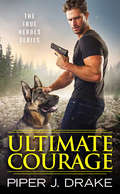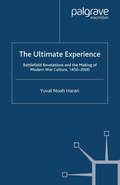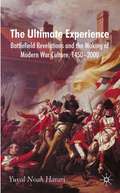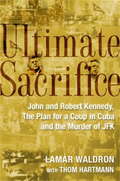- Table View
- List View
U.S. Peacefare: Organizing American Peace-Building Operations (Praeger Security International)
by Dane F. Jr.This book provides a survey of the U.S. civilian and military agencies responsible for postconflict reconstruction and peace-building around the world and how these agencies function in the interagency process.U.S. Peacefare: Organizing American Peace-Building Operations surveys the evolution of the American peace-building apparatus during the presidencies of Bill Clinton and George W. Bush, with an emphasis on changes since 2003, when the invasion of Iraq led the Bush Administration to adopt a Clinton-style nation-building approach they had previously vigorously opposed.U.S. Peacefare begins with a historical overview of official U.S. peace-building, then looks at the organization and interaction of the major federal agencies in the National Security Council, the State Department, and the Defense Department, as well the U.S. Institute for Peace, and the United States Agency for International Development (USAID). Throughout, author and former Ambassador Dane Smith emphasizes how a deeper understanding of peace-building organizations and their interactions in particular cases is essential to strengthening future U.S. conflict management. The book addresses the critical overall issue of how peace-building is funded, but within the federal budget and internationally, and concludes with Smith's recommendations for reforming those organizations.
U.S. Presidents during Wartime: A History of Leadership
by Sean N. Kalic Ethan S. RafuseFrom the American Revolution to the War in Afghanistan, the United States has had no shortage of conflicts on both domestic and world stages. All provide insight into the values of the presidents who led the nation through them.U.S. Presidents during Wartime: A History of Leadership takes readers through chronological entries of presidents who participated in key wars throughout U.S. history. An overview essay first considers the social, economic, and political factors that affected presidents during war. Entries beginning with the presidency of George Washington and ending with that of George W. Bush comprehensively cover each war therein, as well as the responses of the relevant presidents.Primary documents in each entry depict the perspectives of the presidents and offer opportunities for comparing and contrasting the presidents' engagements in wartime strategies. Ending each entry are chronologies of the various events and conflicts that marked the president's time in office. Moreover, entries build upon each other to help readers toward a broader understanding of the sum impact of the wars that the presidents led. While the book emphasizes the historical record, it also explores ongoing conflicts through the lens of contemporary U.S. presidents to provide readers with a complete picture of the changing nature of war over time.
U.S. Presidents during Wartime: A History of Leadership
by Sean N. Kalic Ethan S. RafuseFrom the American Revolution to the War in Afghanistan, the United States has had no shortage of conflicts on both domestic and world stages. All provide insight into the values of the presidents who led the nation through them.U.S. Presidents during Wartime: A History of Leadership takes readers through chronological entries of presidents who participated in key wars throughout U.S. history. An overview essay first considers the social, economic, and political factors that affected presidents during war. Entries beginning with the presidency of George Washington and ending with that of George W. Bush comprehensively cover each war therein, as well as the responses of the relevant presidents.Primary documents in each entry depict the perspectives of the presidents and offer opportunities for comparing and contrasting the presidents' engagements in wartime strategies. Ending each entry are chronologies of the various events and conflicts that marked the president's time in office. Moreover, entries build upon each other to help readers toward a broader understanding of the sum impact of the wars that the presidents led. While the book emphasizes the historical record, it also explores ongoing conflicts through the lens of contemporary U.S. presidents to provide readers with a complete picture of the changing nature of war over time.
U.s. Special Forces: A Guide To America's Special Operations Units - The World's Most Elite Fighting Force
by Samuel A. SouthworthPresident George W. Bush has told all Americans that the war against terrorism would be like no other war. But what does this mean? Who will fight? How will they fight? What weapons will be used? Most informed commentators agree that the war against terrorism will be fought largely by "special forces"-that is, by a relatively new community within the American military known as Special Operations Forces, or SOF's. This new "branch" of the armed forces was created in the mid-1980s and is organized under its own unified command, called U.S. Special Operations Command (SOCOM). Consisting of special units from the other branches of the armed forces, such as Green Berets, Rangers, SEALs, and Delta Force, this new fighting command is recognized internationally as the most well-trained and well-equipped special operations force in the world. Their missions are varied-including combat terrorism, search and rescue, reconnaissance, humanitarian assistance, peacekeeping duty, and conventional and unconventional warfare.Despite special forces' international reputation for excellence, Americans know little about this remarkable fighting force. U.S. Special Forces provides a handy and comprehensive compendium, including descriptions of the units and their operational specialties, training, and organization, as well as the equipment and technological gadgetry, weapons, armor, planes, helicopters, and support vehicles used by each unit.
U.S. Special Warfare: The Elite Combat Skills Of America's Modern Armed Forces
by Samuel SouthworthFor many centuries, the job of everyday soldiers, the "grunts," was the same-"see the hill, take the hill." But the combat role of today's U.S. soldier has undergone a radical change. The recent revolution in the art of soldiering in America emphasizes a smaller, but more highly specialized and technologically equipped, armed force. Now, even everyday soldiers in America's armed forces specialize in elite combat skills that use the very latest high-tech equipment.After basic training, many of today's recruits continue advanced training in one of the new emerging combat specialties, such as urban, mountain and arctic warfare; amphibious, underwater and small boat operations; modern cavalry combat; sniping; military intelligence and psychological warfare; search and rescue procedures, and combat engineering.In lively and entertaining prose, military historian Sam Southworth describes these emerging combat specialties-as well as the training and equipment for each-that characterize America's fighting force today.
Ubique: The Royal Artillery in the Second World War
by Richard DohertyIn Richard Doherty's latest book he looks at the wide-ranging role of the Royal Artillery (RA) during the Second World War, examining its state of preparedness in 1939, the many developments that were introduced during the War, including aerial observation and self-propelled artillery, the growth of the regiment and its effectiveness in its many roles. It is illustrated with stories of the actions of individuals from members of gun detachments to general officers. During the Second World War the Germans assessed the Royal Artillery as the most professional arm of the British Army. British gunners were accurate, effective and efficient and provided fire support for their armoured and infantry colleagues that was better than that in any other army. It is often claimed that British artillery came into its own after the Battle of El Alamein in late 1942. In the opening bombardment of Operation Lightfoot, the massed artillery of the Eighth Army hammered Axis positions and severely damaged the enemy artillery's ability to react. But this was not the first occasion on which the Eighth Army had massed its artillery: it had done so with 200 guns along the Alamein Line in July, and the effectiveness had long been recognised. In fact, the power of a concentrated shoot had been shown by one gunner regiment during the May 1940 Dunkirk campaign. However, the RA provided much more than field and medium artillery battlefield support. Gunner regiments manned anti-tank guns on the frontline and light anti-aircraft guns in divisional regiments to defend against air attack at home and abroad. The RA also helped to protect convoys that brought essential supplies to Britain, and AA gunners had their finest hour when they destroyed the majority of the V-1 flying bombs launched against Britain from June 1944.
UFOs of the First World War: Phantom Airships, Balloons, Aircraft and Other Mysterious Aerial Phenomena
by Nigel WatsonLieutenant R.S. Maxwell took off in his BE2C fighter but saw nothing unusual until 8.25 p.m. when, according to his report: ‘My engine was missing irregularly and it was only by keeping the speed of the machine down to 50 mph that I was able to stay at 10,000 feet. I distinctly saw an artificial light to the north of me, and at about the same height. I followed this light northeast for nearly 20 minutes, but it seemed to go slightly higher and just as quickly as myself, and eventually I lost it completely in the clouds.’ Such sightings occurred frequently during the war. The reasons are fascinating in themselves: the first is that aviation is in its infancy, so light phenomena at altitude are a new experience. The second is fear: for the first time a real threat came from the skies. It wasn’t just the Western Front: on 21 August 1915 twenty New Zealand soldiers allegedly saw eight bread-loaf shaped clouds over Hill 60, Suvla Bay. ‘A British regiment, the First- Fourth Norfolk, of several hundred men, was then noticed marching . . . towards Hill 60.’ They marched into the cloud, which lifted off the ground, and were never seen again.
UH-1 Huey Gunship vs NVA/VC Forces: Vietnam 1962–75 (Duel)
by Peter E. DaviesOften described as the US Army's aerial jeep the UH-1 Iroquois ('Huey') was the general-purpose vehicle that provided mobility in a hostile jungle environment which made rapid troop movement extremely challenging by any other means. Hueys airlifted troops, evacuated casualties, rescued downed pilots, transported cargo externally and enabled rapid transit of commanders in the field. Although 'vertical aviation' had only become a practical reality during the Korean War helicopters evolved rapidly in the decade before Vietnam and by 1965 the US Army and US Marines relied on them as primary combat tools. This was principally because North Vietnam's armed forces had long experience of jungle operations, camouflage and evasion. Generally avoiding set-piece pitched battles they relied on rapid, frequent strikes and withdrew using routes that were generally inaccessible to US vehicles. They commonly relied on darkness and bad weather to make their moves, often rendering them immune to conventional air attack. Gunship helicopters, sometimes equipped with Firefly searchlights and early night vision light intensifiers, were more able to track and attack the enemy. Innovative tactics were required for this unfamiliar combat scenario and for a US Army that was more prepared for conventional operations in a European-type setting. One of the most valuable new initiatives was the UH-1C 'Huey Hog' or 'Frog' gunship, conceived in 1960 and offering more power and agility than the UH-1B that pioneered gunship use in combat. Heavily armed with guns and rockets and easily transportable by air these helicopters became available in large numbers and they became a major problem for the insurgent forces throughout the war.Covering fascinating details of the innovations in tactics and combat introduced by gunship helicopters, this book offers an analysis of their adaptability and usefulness in a variety of operations, while exploring the insurgent forces' responses to the advent of 'vertical aviation'.
UH-1 Huey Gunship vs NVA/VC Forces: Vietnam 1962–75 (Duel)
by Peter E. DaviesOften described as the US Army's aerial jeep the UH-1 Iroquois ('Huey') was the general-purpose vehicle that provided mobility in a hostile jungle environment which made rapid troop movement extremely challenging by any other means. Hueys airlifted troops, evacuated casualties, rescued downed pilots, transported cargo externally and enabled rapid transit of commanders in the field. Although 'vertical aviation' had only become a practical reality during the Korean War helicopters evolved rapidly in the decade before Vietnam and by 1965 the US Army and US Marines relied on them as primary combat tools. This was principally because North Vietnam's armed forces had long experience of jungle operations, camouflage and evasion. Generally avoiding set-piece pitched battles they relied on rapid, frequent strikes and withdrew using routes that were generally inaccessible to US vehicles. They commonly relied on darkness and bad weather to make their moves, often rendering them immune to conventional air attack. Gunship helicopters, sometimes equipped with Firefly searchlights and early night vision light intensifiers, were more able to track and attack the enemy. Innovative tactics were required for this unfamiliar combat scenario and for a US Army that was more prepared for conventional operations in a European-type setting. One of the most valuable new initiatives was the UH-1C 'Huey Hog' or 'Frog' gunship, conceived in 1960 and offering more power and agility than the UH-1B that pioneered gunship use in combat. Heavily armed with guns and rockets and easily transportable by air these helicopters became available in large numbers and they became a major problem for the insurgent forces throughout the war.Covering fascinating details of the innovations in tactics and combat introduced by gunship helicopters, this book offers an analysis of their adaptability and usefulness in a variety of operations, while exploring the insurgent forces' responses to the advent of 'vertical aviation'.
UK Communication Strategies for Afghanistan, 2001–2014
by Thomas W. CawkwellThe war in Afghanistan came to an end in 2014 after nearly thirteen years of conflict. Throughout that period, British officials have described UK operations there in various conflicting and often contradictory ways; as a counter-terrorism mission, a stabilisation mission, and a counter-narcotics mission, respectively. This book investigates how the war was ’sold’ to the British public and how Britain’s ’transnational’ foreign and defence policy impacted on the unfolding of UK strategy in Afghanistan and the way it was communicated. It argues that because the UK’s foreign and defence policy is transnationally-oriented - meaning that it is foundationally aimed at maintaining alliance with the United States and the institutional coherence of NATO - UK strategy is contingent upon collective security and, crucially, is fundamentally concerned with the means of policy (maintaining alliances) over the ends (using alliances to effect change). Explaining the inalienability of collective security systems to national security is no easy task, however, and, when faced with the adversities of Afghanistan, the UK state has since 2008 instead opted to describe the significance of Afghanistan in narrow, nation-centric, counter-terrorist concerns in order to maintain public support for collective security operations there whilst, paradoxically, framing the conflict in a manner that avoids talking about the transnational structure and purpose of the mission. This kind of ’strategic’ communication is increasingly becoming a focus of the UK state as it faces a transnational dilemma of maintaining its collective security bonds whilst facing a public increasingly sceptical of liberal interventionism.
UK Communication Strategies for Afghanistan, 2001–2014
by Thomas W. CawkwellThe war in Afghanistan came to an end in 2014 after nearly thirteen years of conflict. Throughout that period, British officials have described UK operations there in various conflicting and often contradictory ways; as a counter-terrorism mission, a stabilisation mission, and a counter-narcotics mission, respectively. This book investigates how the war was ’sold’ to the British public and how Britain’s ’transnational’ foreign and defence policy impacted on the unfolding of UK strategy in Afghanistan and the way it was communicated. It argues that because the UK’s foreign and defence policy is transnationally-oriented - meaning that it is foundationally aimed at maintaining alliance with the United States and the institutional coherence of NATO - UK strategy is contingent upon collective security and, crucially, is fundamentally concerned with the means of policy (maintaining alliances) over the ends (using alliances to effect change). Explaining the inalienability of collective security systems to national security is no easy task, however, and, when faced with the adversities of Afghanistan, the UK state has since 2008 instead opted to describe the significance of Afghanistan in narrow, nation-centric, counter-terrorist concerns in order to maintain public support for collective security operations there whilst, paradoxically, framing the conflict in a manner that avoids talking about the transnational structure and purpose of the mission. This kind of ’strategic’ communication is increasingly becoming a focus of the UK state as it faces a transnational dilemma of maintaining its collective security bonds whilst facing a public increasingly sceptical of liberal interventionism.
Ukraine 22: Ukrainian Writers Respond to War
by Mark Andryczyk'The extraordinary writers in this volume articulate the taste, the terror, and the dialect of war; they command their powers of description to face a shameless empire intent on annihilating them' Ellena SavageA selection of Ukraine's leading writers convey the reality of life within Ukraine during the first year of the invasionOn 24 February 2022, the lives of Ukrainians were devastatingly altered. Since that day, many of Ukraine's writers have attempted to fathom what is happening to them and to their country. This anthology brings together writing from inside Ukraine, by Ukrainians, available in English for the first time. Here they document everyday life, ponder the role of culture amid conflict, denounce Russian imperialism and revisit their relations with the world, especially Europe and its ideals, as they try to comprehend the horrors of war.From tearing-downs of Russia's use of culture as justification of the war to moving descriptions of nights spent sheltering in corridors, poignant snatched moments with a husband on his single night away from the army, to descriptions of the eerie weather in the months leading up to the invasion, as if nature was trying to warn Ukraine, these essays reveal the texture, rawness and reality of life in Ukraine under war as never before.
Ukraine and the Art of Strategy
by Lawrence FreedmanThe Russian invasion of Crimea in 2014, subsequent war in Eastern Ukraine and economic sanctions imposed by the West, transformed European politics. These events marked a dramatic shift away from the optimism of the post-Cold War era. The conflict did not escalate to the levels originally feared but nor was either side able to bring it to a definitive conclusion. Ukraine suffered a loss of territory but was not forced into changing its policies away from the Westward course adopted as a result of the EuroMaidan uprising of February 2014. President Putin was left supporting a separatist enclave as Russia's economy suffered significant damage. In Ukraine and the Art of Strategy, Lawrence Freedman-author of the landmark Strategy: A History-provides an account of the origins and course of the Russia-Ukraine conflict through the lens of strategy. Freedman describes the development of President Putin's anxieties that former Soviet countries were being drawn towards the European Union, the effective pressure he put on President Yanokvych of Ukraine during 2013 to turn away from the EU and the resulting 'EuroMaidan Revolution' which led to Yanukovych fleeing. He explores the reluctance of Putin to use Russian forces to do more that consolidate the insurgency in Eastern Ukraine, the failure of the Minsk peace process and the limits of the international response. Putin's strategic-making is kept in view at all times, including his use of 'information warfare' and attempts to influence the American election. In contrast to those who see the Russian leader as a master operator who catches out the West with bold moves Freedman sees him as impulsive and so forced to improvise when his gambles fail. Freedman's application of his strategic perspective to this supremely important conflict challenges our understanding of some of its key features and the idea that Vladimir Putin is unmatched as a strategic mastermind.
Ukraine and the Art of Strategy
by Lawrence FreedmanThe Russian invasion of Crimea in 2014, subsequent war in Eastern Ukraine and economic sanctions imposed by the West, transformed European politics. These events marked a dramatic shift away from the optimism of the post-Cold War era. The conflict did not escalate to the levels originally feared but nor was either side able to bring it to a definitive conclusion. Ukraine suffered a loss of territory but was not forced into changing its policies away from the Westward course adopted as a result of the EuroMaidan uprising of February 2014. President Putin was left supporting a separatist enclave as Russia's economy suffered significant damage. In Ukraine and the Art of Strategy, Lawrence Freedman-author of the landmark Strategy: A History-provides an account of the origins and course of the Russia-Ukraine conflict through the lens of strategy. Freedman describes the development of President Putin's anxieties that former Soviet countries were being drawn towards the European Union, the effective pressure he put on President Yanokvych of Ukraine during 2013 to turn away from the EU and the resulting 'EuroMaidan Revolution' which led to Yanukovych fleeing. He explores the reluctance of Putin to use Russian forces to do more that consolidate the insurgency in Eastern Ukraine, the failure of the Minsk peace process and the limits of the international response. Putin's strategic-making is kept in view at all times, including his use of 'information warfare' and attempts to influence the American election. In contrast to those who see the Russian leader as a master operator who catches out the West with bold moves Freedman sees him as impulsive and so forced to improvise when his gambles fail. Freedman's application of his strategic perspective to this supremely important conflict challenges our understanding of some of its key features and the idea that Vladimir Putin is unmatched as a strategic mastermind.
Ukraine’s Nuclear Disarmament: A History (Harvard Series in Ukrainian Studies; #78)
by Yuri KostenkoIn December 1994 Ukraine gave up the third-largest nuclear arsenal in the world and signed the Non-Proliferation Treaty, having received assurances that its sovereignty would be respected and secured by Russia, the United States, and the United Kingdom. Based on original and heretofore unavailable documents, Yuri Kostenko’s account of the negotiations between Ukraine, Russia, and the US, reveals for the first time the internal debates of the Ukrainian government, as well as the pressure exerted upon it by its international partners. Kostenko presents an insider’s view on the issue of nuclear disarmament and raises the question of whether the complete and immediate dismantlement of the country’s enormous nuclear arsenal was strategically the right decision, especially in view of the 2014 annexation of Crimea by Russia, one of the guarantors of Ukraine’s sovereignty under denuclearization.
Ukraine’s Nuclear Disarmament: A History (Harvard Series in Ukrainian Studies; #78)
by Yuri KostenkoIn December 1994 Ukraine gave up the third-largest nuclear arsenal in the world and signed the Non-Proliferation Treaty, having received assurances that its sovereignty would be respected and secured by Russia, the United States, and the United Kingdom. Based on original and heretofore unavailable documents, Yuri Kostenko’s account of the negotiations between Ukraine, Russia, and the US, reveals for the first time the internal debates of the Ukrainian government, as well as the pressure exerted upon it by its international partners. Kostenko presents an insider’s view on the issue of nuclear disarmament and raises the question of whether the complete and immediate dismantlement of the country’s enormous nuclear arsenal was strategically the right decision, especially in view of the 2014 annexation of Crimea by Russia, one of the guarantors of Ukraine’s sovereignty under denuclearization.
Ukraine’s Nuclear Disarmament: A History (Harvard Series in Ukrainian Studies; #78)
by Yuri KostenkoIn December 1994, Ukraine gave up the third-largest nuclear arsenal in the world and signed the Non-Proliferation Treaty, having received assurances that its sovereignty would be respected and secured by Russia, the United States, and the United Kingdom. Based on original and heretofore unavailable documents, Yuri Kostenko’s account of the negotiations between Ukraine, Russia, and the US reveals for the first time the internal debates of the Ukrainian government as well as the pressure exerted upon it by its international partners.Kostenko presents an insider’s view on the issue of nuclear disarmament and raises the question of whether the complete and immediate dismantlement of the country’s enormous nuclear arsenal was strategically the right decision, especially in view of the 2014 annexation of Crimea by Russia, one of the guarantors of Ukraine’s sovereignty under denuclearization.
Ukraine’s Nuclear Disarmament: A History (Harvard Series in Ukrainian Studies; #78)
by Yuri KostenkoIn December 1994, Ukraine gave up the third-largest nuclear arsenal in the world and signed the Non-Proliferation Treaty, having received assurances that its sovereignty would be respected and secured by Russia, the United States, and the United Kingdom. Based on original and heretofore unavailable documents, Yuri Kostenko’s account of the negotiations between Ukraine, Russia, and the US reveals for the first time the internal debates of the Ukrainian government as well as the pressure exerted upon it by its international partners.Kostenko presents an insider’s view on the issue of nuclear disarmament and raises the question of whether the complete and immediate dismantlement of the country’s enormous nuclear arsenal was strategically the right decision, especially in view of the 2014 annexation of Crimea by Russia, one of the guarantors of Ukraine’s sovereignty under denuclearization.
Ukrainian Armies 1914–55 (Men-at-Arms #412)
by Peter Abbott Eugene PinakThere can be no region in Europe whose history has been more tortured than Ukraine. During the 20th century Austria, Poland, Russia, Germany, Hungary, Czechoslovakia and Romania vied for power over parts of this vast and fragmented area; and its divided peoples rose time and again in vain attempts to win their independence. For the first time in the West, this book gives a succinct summary of all the different armed forces raised among the Ukrainians, and of their uniforms and insignia. These are illustrated in colour and in a selection of extremely rare photographs, dating from the Great War to the aftermath of World War II, when Ukrainian guerrillas continued to defy the Soviet authorities until the mid-1950s.
Ukrainian Armies 1914–55 (Men-at-Arms)
by Peter Abbott Oleksiy Rudenko Eugene PinakThere can be no region in Europe whose history has been more tortured than Ukraine. During the 20th century Austria, Poland, Russia, Germany, Hungary, Czechoslovakia and Romania vied for power over parts of this vast and fragmented area; and its divided peoples rose time and again in vain attempts to win their independence. For the first time in the West, this book gives a succinct summary of all the different armed forces raised among the Ukrainians, and of their uniforms and insignia. These are illustrated in colour and in a selection of extremely rare photographs, dating from the Great War to the aftermath of World War II, when Ukrainian guerrillas continued to defy the Soviet authorities until the mid-1950s.
Ulster, Ireland and the Somme: War Memorials and Battlefield Pilgrimages
by Catherine SwitzerUlster, Ireland and the Somme tells the story of the relationship between Ulster, Ireland and the Somme area of northern France, which has now endured for nearly a century. The 1916 Battle of the Somme is a key event in Irish memory of the Great War, and thousands of people from both Northern Ireland and the Irish Republic visit the area each year, but the history of the landscape and the memorials they see has never been told in any detail until now.
Ultimate Courage (True Heroes #2)
by Piper J. DrakeLOVE IS AN ACT OF BRAVERYRetired Navy SEAL Alex Rojas is putting his life back together, one piece at a time. Being a single dad to his young daughter and working at Hope's Crossing Kennels to help rehab a former guard dog, he struggles every day to control his PTSD. But when Elisa Hall shows up, on the run and way too cautious, she unleashes his every protective instinct. Elisa's past never stays in her rearview mirror for long, and she refuses to put anyone else in danger. But with Alex guarding her so fiercely yet looking at her so tenderly, she's never felt safer . . . or more terrified that the secrets she keeps could put countless people in grave peril. The only way for both to fully escape their demons will take the ultimate act of courage: letting go and learning to trust each other.
The Ultimate Experience: Battlefield Revelations and the Making of Modern War Culture, 1450-2000
by Y. HarariFor millennia, war was viewed as a supreme test. In the period 1750-1850 war became much more than a test: it became a secular revelation. This new understanding of war as revelation completely transformed Western war culture, revolutionizing politics, the personal experience of war, the status of common soldiers, and the tenets of military theory.
The Ultimate Experience: Battlefield Revelations And The Making Of Modern War Culture, 1450-2000 (PDF)
by Yuval Noah HarariFor millennia, war was viewed as a supreme test. In the period 1750-1850 war became much more than a test: it became a secular revelation. This new understanding of war as revelation completely transformed Western war culture, revolutionizing politics, the personal experience of war, the status of common soldiers, and the tenets of military theory.
Ultimate Sacrifice: John And Robert Kennedy, The Plan For A Coup In Cuba, And The Murder Of Jfk
by Thom Hartmann Lamar WaldronDrawing on seventeen years of research, thousands of recently declassified files, and dozens of interviews, Ultimate Sacrifice re-creates and, in many ways, rewrites the crucial period of our history leading up to November 22 1923. In the process, this groundbreaking account provides the missing pieces to the greatest tragic puzzle of post-war America: the true circumstances behind the assassination of President John F. Kennedy. · Ultimate Sacrifice details a previously unknown “Plan for a Coup in Cuba” authorized by President John Kennedy, run by Attorney General Robert Kennedy and set for December 1, 1963. · The Kennedy plan, unique and different from ant previously disclosed operation, was – as detailed in a Joint Chiefs of Staff memo – to have included a “palace coup”, a provisional Cuban government and, if necessary, a “full-scale invasion” by “invited” US military forces. · The CIA’s code name for their part of the operation, AMWORLD, has never previously surfaced in any government investigation, nor in any book or article, making it one of the most covert operations in United States history. · Ultimate Sacrifice will detail how the Kennedy plan was penetrated by three mafia godfathers – Carlos Marcello, Santo Trafficante, and Johnny Roselli – being vigorously pursued by Attorney General Robert Kennedy, along with a dozen of their associates, six of whom were also working on the Coup plan. · The crime bosses then used parts of the Coup Plan/AMWORLD to arrange JFK’s assassination in a way that would prevent a truly thorough government investigation in order to protect the Coup Plan, its participants, and national security. · By using the secrecy surrounding the Plan, the mob bosses would target JFK not only in Dallas but in two earlier attempts, one in Chicago on November 1 and them one in Tampa on November 18, which Ultimate Sacrifice reveals for the first time in any book. · Ultimate Sacrifice has finally pieced together the whole story by building on the work of the seven governmental committees that have investigated aspects of the assassination, on the work of former government investigators, and on the four million documents that were declassified in the 1990s, in addition to exclusive interviews with dozens of witnesses and participants including Secretary of State Dean Rusk, Press Secretary Pierre Salinger, and the Kennedys’ closest Cuban exile aide, Harry “Ruiz” Williams.
